NorthEast Radio Watch 12/23 & 12/30/2024: WKIT Lives!
In this week’s issue… WKIT finds a buyer - Eskin out at WIP - Staff shifts in Utica - CRTC approves Bell divestitures
Text and photos by SCOTT FYBUSH
You know what’s a big place? Florida’s Brevard County is a big place, at least if you’re traveling from north to south. Sprawling along the state’s Atlantic coast for some 79 miles, Brevard County touches the edge of Daytona Beach on the north side and begins its descent into the sprawl of the Palm Beaches on the south. And in the middle, of course, sits Kennedy Space Center, where the launch of STS-133 two years ago this month was the reason for the entire Florida trip that we’ve been documenting here on Site of the Week.
The pictures we’re showing you this week were taken over the span of several days in February 2011, with some big non-radio interruptions for the aforementioned Shuttle launch and a long afternoon tour of Cape Canaveral. Around those visits, though, we managed to see most (if not quite all) of Brevard’s broadcast facilities, at least from the outside, starting above at left with the northernmost AM in Brevard.
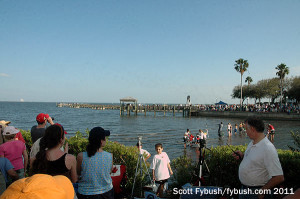

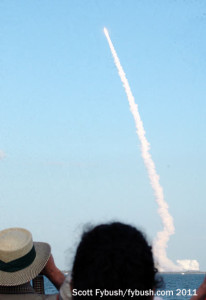

When we pulled off I-95 about 35 miles south of Daytona Beach early in the afternoon on the day of the launch, we were deep in Florida farm country as we pulled up to the single tower of what was then WGRU. This 1000-watt daytimer was doing smooth jazz as “The Groove,” part of a mini-network that also included a low-power FM down in Melbourne, but just a few weeks after our visit it flipped to country and has since returned to its earlier call letters, WPGS.
About half an hour later, we pulled off US 1 into Titusville, where crowds were already building at Space View Park awaiting a launch scheduled for about 4:45 that afternoon. We wedged our way into a little space near the edge of the park, where only the wide Indian River separated us from the launch pad off in the distance at Kennedy. And after four hours or so of waiting around, we were treated to one of the most amazing spectacles America has (or at least had) to offer: a blindingly bright light, a rumble and noise a little less intense than we’d been led to expect, and then the stately sight of the shuttle headed up to space atop a trail of smoke that lingered in the Florida sky for much longer than anyone tells you it will.
The other thing nobody prepares you for is the traffic: after crowds build up in and around Titusville and for a hundred miles up and down the coast for more than a day, everyone pretty much all wants to leave at once. And most of them want to do the same thing we did: get back to hotels in the Orlando area, 50 miles or so inland to the west. Here’s the part where you’re welcome to pause and look at a map to see that there are only a handful of roads to get out of town: only state highways 46 and 50 and the “Beach Line Expressway” (Florida 528) cross the Seminole Ranch wildlife area that separates the Brevard coast from Orlando, and the drive can easily take four to six hours after a launch. If memory serves, it took us something north of three hours that Thursday night to get to our hotel down by Kissimmee, via the roundabout northerly route 46. That road took us past the five-tower site of WIXC (1060), the lone AM station licensed to Titusville, but by then it was well past dark, so we missed it, alas.
We spent all day the next day, Friday, seeing the sites of Orlando, which we’ll show to you next week, but on Saturday we returned to the Space Coast on a far less crowded Beach Line to see the sites of Melbourne and Cocoa and to tour Cape Canaveral. Cocoa, first (even though we actually saw these sites at day’s end, after the Canaveral tour): tucked in here along the Indian River some 15 miles south of Titusville, this faded city is home to three AM stations and several FMs as well.
WMMV (1350 Cocoa) dates back to 1957, right at the start of the space boom in this once-sleepy town. That’s when it signed on as WEZY on 1480. By 1960, it had moved to 1350, using (I believe) those same three short AM towers on the north side of town that it still uses today. The taller FM tower seen at left came later, with the 1967 debut (under then-owner Gannett, which still owns the local paper, Florida Today) of the FM sister now known as WLRQ (99.3). The FM’s not here anymore – it’s on a tower we didn’t see near Rockledge, south of Cocoa – but there are still what I believe to be aux bays on that tower.
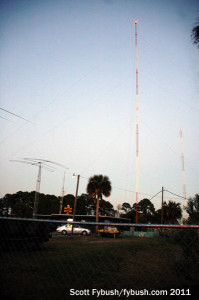

Cocoa follows the same general layout as so many of these coast towns – I-95 on the west side of town, US 1 paralleling it a little closer to the coastal waterway, and a main east-west drag linking those north-south highways to a causeway leading to the barrier island and the beach. In Cocoa, that’s called King Street, and right by downtown is where we find the self-supporting tower that holds, among other things, religious outlet WMIE (91.5 Cocoa).
Two more AMs complete today’s Cocoa dial, and they’re located close to each other just south of King Street and east of 95. On Pluckebaum Road, WMEL (1300 Cocoa Beach) is the descendant of WRKT (“Rocket,” of course), which signed on here in 1957. Later known as WXXU and WTIR (in a travelers’-information incarnation that at least one regular Tower Site reader would rather forget), 1300 became talk radio WMEL in 2008, picking up those calls and that format from AM 920 in Melbourne, about which more in a bit. In its current incarnation on 1300, WMEL had served an important purpose for us on launch day: during shuttle missions, it carried NASA audio. That was especially useful where we were standing, out of earshot of the speakers set up elsewhere in the park and in an area where the cellular data networks were thoroughly overloaded.
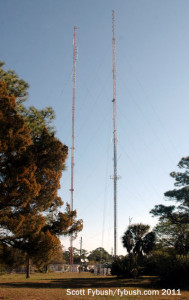

The newest AM in the area signed on in 1965. Daytimer WWBC (1510 Cocoa) cranks out 50,000 watts (25,000 during critical hours) from these two towers on Burnett Road, and these days it’s doing religion. This is also right around where the town’s original AM was located. WKKO (860 Cocoa) signed on back in 1953 as a daytimer and lasted until 2000, when the station (by then WRFB) was taken silent to allow another 860 in the Tampa area to boost power. (We’ll catch up with that 860 in a future installment.)
There’s an FM site near here, too: WHKR (102.7 Rockledge) is right around the corner, but it was getting awfully dark by this point and we have only a blurry photo of its tower.
Earlier in the day, however, we’d started out with plenty of bright sunshine another 20 miles or so to the south in Melbourne, the southern population center of Brevard County.
Our first stop was just off I-95 in Eau Gallie, the town just north of Melbourne, where an unusual two-tower site carries most of the city’s FMs. Clear Channel’s top-40 “Kiss” WBVD (95.1 Melbourne, later renamed WFKS), its Cumulus competitor “WA1A” WAOA-FM (107.1 Melbourne), religious WCIF (106.3 Melbourne) and oldies WSBH (98.5 Satellite Beach) all have antennas here.
The WSBH studios are in a classically-Florida strip mall on Wickham Road, on the way from Eau Gallie into Melbourne, and the two bigger broadcast groups with clusters here have studios nearby, amidst the suburban sprawl of Melbourne’s north side.
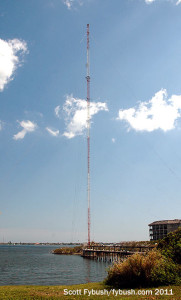

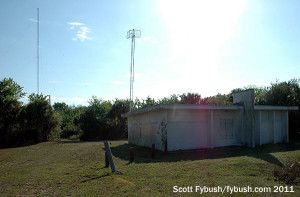

Cumulus here includes WAOA-FM, WHKR (country “Hit Kicker”), and sports outlets WSJZ (95.9 Sebastian, to the south) and WINT (1560 Melbourne, about which more in a moment). Clear Channel, which has its studios inside a shopping mall, includes “Kiss,” WLRQ (Lite Rock 99.3) and the talk simulcast of WMMV up in Cocoa and WMMB (1240) here in Melbourne.
WMMB’s tower and a former studio building sit right on the edge of the Indian River near downtown Melbourne (where we can most heartily recommend the Chicago-style hot dogs at Mustard’s Last Stand, but we digress!)
WMMB started out as a daytimer on 1050 way back in 1948, when hardly anyone lived amidst the mosquitoes in Brevard County yet. It moved to fulltime operation on 1240 in 1951, and in later years it was owned by Chicago radio personality Howard Miller before being sold several times and ending up with Capstar and later Clear Channel.
WINT joined the party in 1968, transmitting from a site just west of I-95 in Eau Gallie. When we pulled up there in 2011, the 5000-watt daytime station had gone silent due to a severe copper theft at that same site; two years later, it remains silent, though the signal is now parking the WLZR calls that used to be in Milwaukee.
Our final AM stop in Brevard County is also in Eau Gallie, on Turtle Mound Road east of the FM towers. This four-tower site is the longtime home of the 5000-watt signal on 920, which started out back in 1956 as WMEG (“Melbourne and Eau Gallie”) and became WMEL in the early 1970s, after Eau Gallie was incorporated into a larger city of Melbourne. After the WMEL calls moved north to 1300 in 2008, 920 became Catholic radio WDMC (“Divine Mercy Communications”), and that’s what it’s doing now.
(One more Brevard note: there are two more FMs licensed to Cocoa and Cocoa Beach, but they’re big C-class signals that long ago got poached by the much larger Orlando market to the west. What started out in 1962 as WRKT-FM 104.1, sister to WRKT 1300, eventually became WSSP and is now Clear Channel hot talker WTKS; on 101.1, the station that started in 1963 as classical WXBR and was later WCKS, sister to WKKO 860, is now Clear Channel active rocker WJRR.)
This is as far south as we ranged on Florida’s east coast, which means we have some serious traveling yet to do someday to take us from Vero Beach, the next city to the south, down through West Palm Beach and Fort Lauderdale, into the swamps of Miami and down to the Keys. But on our 2011 trip, the route from here took us inland, so join us next week to see the first of several Orlando installments.
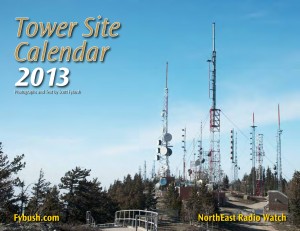

Want access to more than a dozen years’ worth of Tower Site of the Week? All our archives, fully searchable, are available to Fybush.com subscribers – and you get full access to NorthEast Radio Watch, too! Subscriptions start at just $15. Sign up here!
And don’t miss a batch of Space Coast IDs next Wednesday, over at our sister site, TopHour.com!
Next week: Orlando 2011, part I
In this week’s issue… WKIT finds a buyer - Eskin out at WIP - Staff shifts in Utica - CRTC approves Bell divestitures
In this week’s issue… WBUR backs off local talk - EMF's expansion in NY, nationally - Rochester broadcasters honored - Russell finds new PA radio home - Remembering Bruce Stevens - The new calendar's here!
In this week’s issue… Remembering WNY's Palvino, Harris - Will King sell Bangor stations? - Kay moves earlier - New signal on LI - Cumulus cuts hit PA, New England - Frizzell sells in NH
In this week’s issue… Saluting a small-town radio vet - Bell moves CP24 - Scott heads west - Burlington gets Air 1, "Experimental Radio" - Family Life heads down I-86